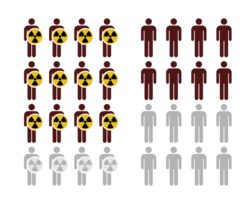Medicine:Number needed to harm
In medicine, the number needed to harm (NNH) is an epidemiological measure that indicates how many persons on average need to be exposed to a risk factor over a specific period to cause harm in an average of one person who would not otherwise have been harmed. It is defined as the inverse of the absolute risk increase, and computed as [math]\displaystyle{ 1/(I_e - I_u) }[/math], where [math]\displaystyle{ I_e }[/math] is the incidence in the treated (exposed) group, and [math]\displaystyle{ I_u }[/math] is the incidence in the control (unexposed) group.[1] Intuitively, the lower the number needed to harm, the worse the risk factor, with 1 meaning that every exposed person is harmed.
NNH is similar to number needed to treat (NNT), where NNT usually refers to a positive therapeutic result and NNH to a detrimental effect or risk factor.
Marginal metrics:
- NNT for an additional beneficial outcome (NNTB)
- NNT for an additional harmful outcome (NNTH)
are also used.[2]
Relevance
The NNH is an important measure in evidence-based medicine and helps physicians decide whether it is prudent to proceed with a particular treatment which may expose the patient to harms while providing therapeutic benefits. If a clinical endpoint is devastating enough without the drug (e.g. death, heart attack), drugs with a low NNH may still be indicated in particular situations if the NNT is smaller than the NNH.[dubious ][citation needed] However, there are several important problems with the NNH, involving bias and lack of reliable confidence intervals, as well as difficulties in excluding the possibility of no difference between two treatments or groups.[3]
Numerical example
| Example of risk increase | |||
|---|---|---|---|
| Experimental group (E) | Control group (C) | Total | |
| Events (E) | EE = 75 | CE = 100 | 175 |
| Non-events (N) | EN = 75 | CN = 150 | 225 |
| Total subjects (S) | ES = EE + EN = 150 | CS = CE + CN = 250 | 400 |
| Event rate (ER) | EER = EE / ES = 0.5, or 50% | CER = CE / CS = 0.4, or 40% | |
| Equation | Variable | Abbr. | Value |
|---|---|---|---|
| EER − CER | absolute risk increase | ARI | 0.1, or 10% |
| (EER − CER) / CER | relative risk increase | RRI | 0.25, or 25% |
| 1 / (EER − CER) | number needed to harm | NNH | 10 |
| EER / CER | risk ratio | RR | 1.25 |
| (EE / EN) / (CE / CN) | odds ratio | OR | 1.5 |
| (EER − CER) / EER | attributable fraction among the exposed | AFe | 0.2 |
See also
References
- ↑ Porta, Miquel; Greenland, Sander; Hernán, Miguel; Silva, Isabel dos Santos; Last, John M. (2014) (in en). Dictionary of Epidemiology - Oxford Reference. doi:10.1093/acref/9780199976720.001.0001. ISBN 9780199976720.
- ↑ Schünemann, Holger J (2023). "Cochrane Handbook for Systematic Reviews of Interventions". Cochrane Training. https://training.cochrane.org/handbook/current/chapter-15. Retrieved 3 October 2023. "[NNH] can easily[citation needed] be read to imply the number of people who will experience a harmful outcome if given the intervention ... The preferred alternative is to use phrases such as 'number needed to treat for an additional beneficial outcome' (NNTB) and 'number needed to treat for an additional harmful outcome' (NNTH) to indicate direction of effect."
- ↑ Hutton JL (2010). "Misleading Statistics: The Problems Surrounding Number Needed to Treat and Number Needed to Harm". Pharm Med 24 (3): 145–9. doi:10.1007/BF03256810.
 |


